I walked down Courso Venezia, to visit the Fornasetti shop, from there I turned left at Armani Casa and turned onto the small quiet street, 1 block down to locate this Villa I had read about…. I arrive at a gate and felt like I was entering a secret garden. A garden of mature Magnolia trees, I walked beneath the marble arches of the wisteria walk and then the garden opens up to a pool and I catch my first glimpse of the Villa. It is grand, yet simple and elegant all at the same time.

Built by Angelo Campiglio and his wife Gigina Necchi and sister Nedda Necchi, they selected leading Milan Architect Piero Portaluppi (1888-1967) who was already building several residences in the neighbourhood. With a distinctive career in architecture, city planning, decorative arts, restoration, exhibition display as well as writing and teaching. Portaluppi was well established and considered brilliant and creative.

This neighbourhood was part of a larger Palazzo that the city arranged to obtain portions of the garden with limitations regarding construction and consideration to retain green areas of the mature garden.
The elegant front entrance of the Villa with the semi circle of cascading stairs in marble, the semi circle canopy overhang with circles for the light fixtures. The curve in in contrast to the horizontal lines of the facade – Portoluppi was known for his use of contrast – the materials used are smooth and rough, polished and matte finishes, glass and wood and marble and brass. Lack of trim, cornices and decorative details and embellishments was a complete departure from the architecture of the time – yet the modern villa is grand, luxurious and still comfortable family home that entertained the affluent, upper class, La Scala theatre singers, actors and producers, and aristocracy, including European royalty.

View to the garden, that hides the villa from the street.

Entrance – vast, open space with double height ceiling – large walnut planks of hardwood (again, new and modern for the time) marble stairs, Art Deco inspired railing, all Portaluppi designs.

View through the left wing off the entrance – rooms for conversation – a library, games tables, formal living room and veranda. Great Sightline and I love the marble framed doorways.

Detail entrance stairwell.
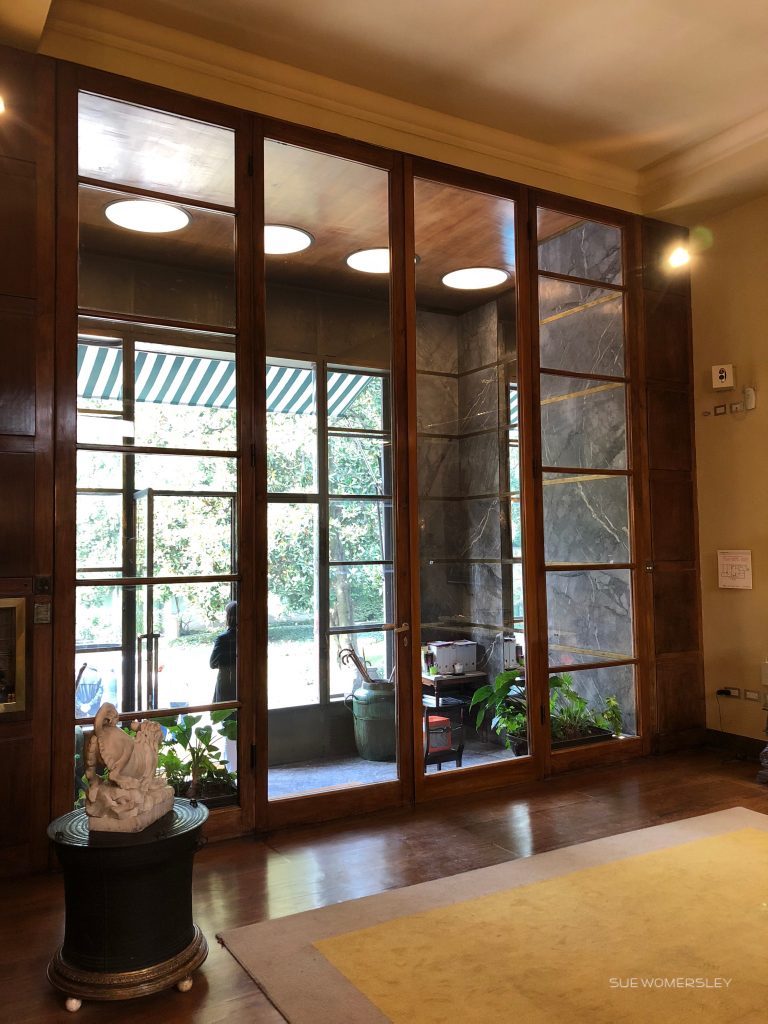
Entrance front door area – linear windows and marble walls with brass trim. More circular lights.

Library with original rosewood built ins and dynamic ceiling detail by architect Portoluppi, which was a signature of his.

The large space is divided into smaller conversation areas by the bookcases, the full height style a complete departure from his contemporaries. The fireplace in a pale and dark granite integrated into the shelving was also a Portaluppi design.

Living Room – during WWII Villa Necchi Campiglio was confiscated by the Fascists and Mussolini. Then British Forces were in the Villa until it was returned to Necchi Campiglio in 1950. Designer Tomaso Buzzi worked with the family for forty years and after the war, as Italy regained itself, a taste for more traditional decor was transitioned to. Buzzi restored the home before the Necchi Campiglios return from evacuation. Tomaso Buzzi helped found architecture magazine Domus and worked with Gio Ponti and was also a lecturer.

Living room – elaborate embroidered draperies, eighteenth century furniture, Louis XV chandelier. Quite a departure and evolution from the original clean simple modern living room design – but this room has also stood the test of time.

The Veranda – this was the latest in architecture at the time – the relationship of the indoor to the outdoor. Portoluppi designed a 3 part system of double paned glass and wood shutters to offer different options of openess or privacy, depending on the season. A table made of precious stone Lapis lazuli is also of the architects design. The floor is travertine and marble. A veranda in a country home was not unusual, but this home in the heart of the city, with two walls of glass as almost a greenhouse, was a security concern.

Portoluppi designed these extraordinary doors – massive gates made of rare German silver, that locked, but were also a unique decorative feature.

A music room was considered essential in an upper class home, and early photos showed a grand piano in this room, it was replaced at some time with this rococo desk.
The Necchi Campiglio’s were kind, generous and hospitable hosts and well liked in society and regularly hosted European royalty.

View to the study from entrance
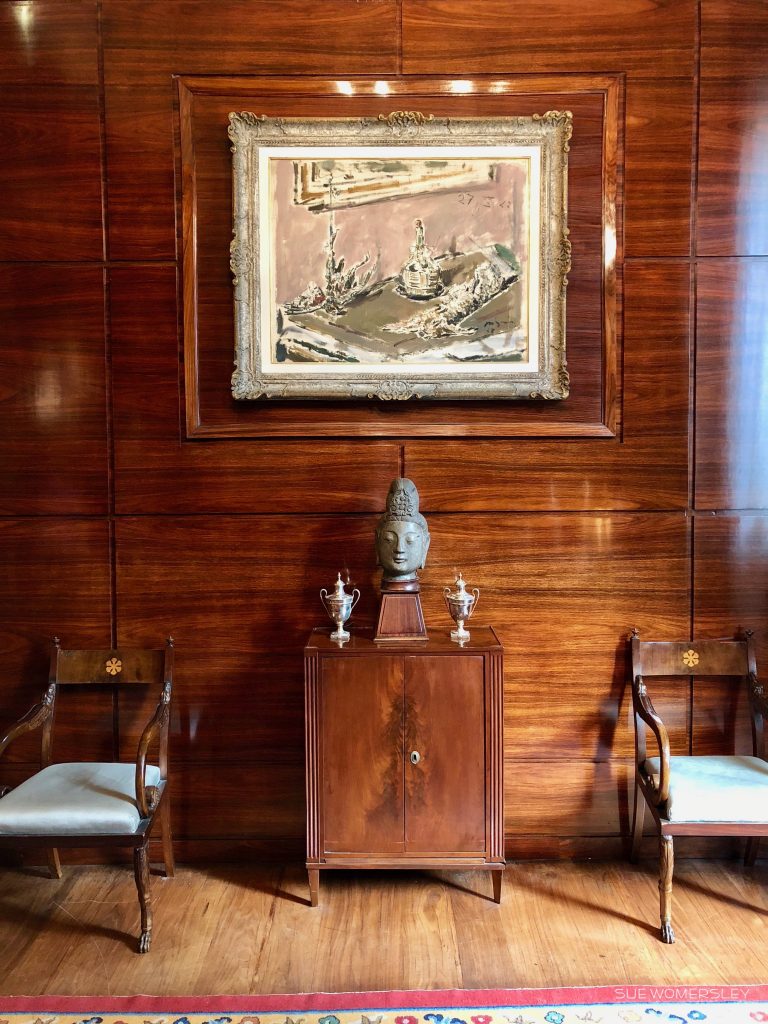
Rosewood panelling walls. Somewhere the panelling conceals a safe. The artwork throughout the home is actually by donation of other families and not a part of the original Necchi Campiglio estate.

A campaign desk, that actually folds up. Note the architect designed grille behind the desk.

The parchment panelling and stuccoed ceiling details including astrology are the only remaining details from Portoluppi. The eighteenth century furniture, chandelier and tapestries were brought in by Buzzi, as well as the custom marble and iron shelves.

Original chair fabric ( the others protected by covers).
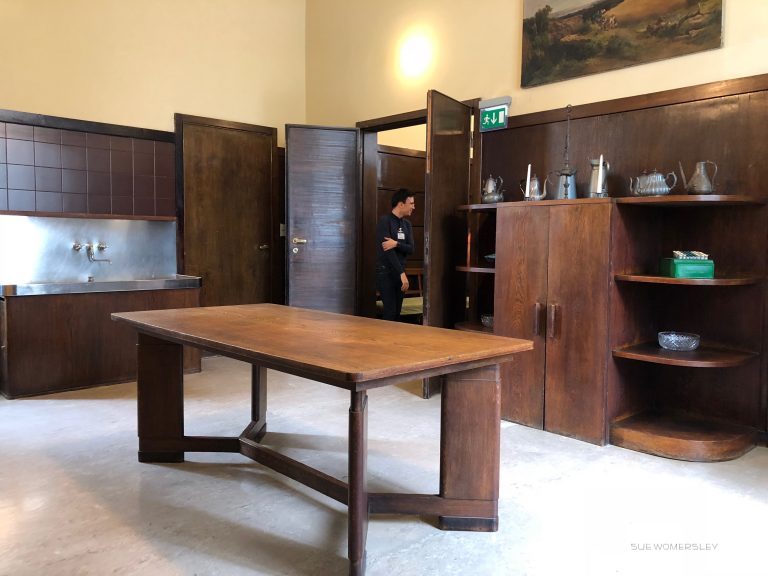
You can see the attention of detail by the architect here – this is one of two pantries adjoining the dining room for service staff. The entire wall behind me is floor to ceiling cabinets full of china and silver ware.
Modern conveniences that were new at the time and only the affluent could enjoy included the dumb waiters, electric bells, telephone, kitchen equipment and heating systems. The kitchen is located in the basement, as was traditional in Italian palazzi for safety, cleanliness and etiquette. There is also a back stairwell to get to the basement.
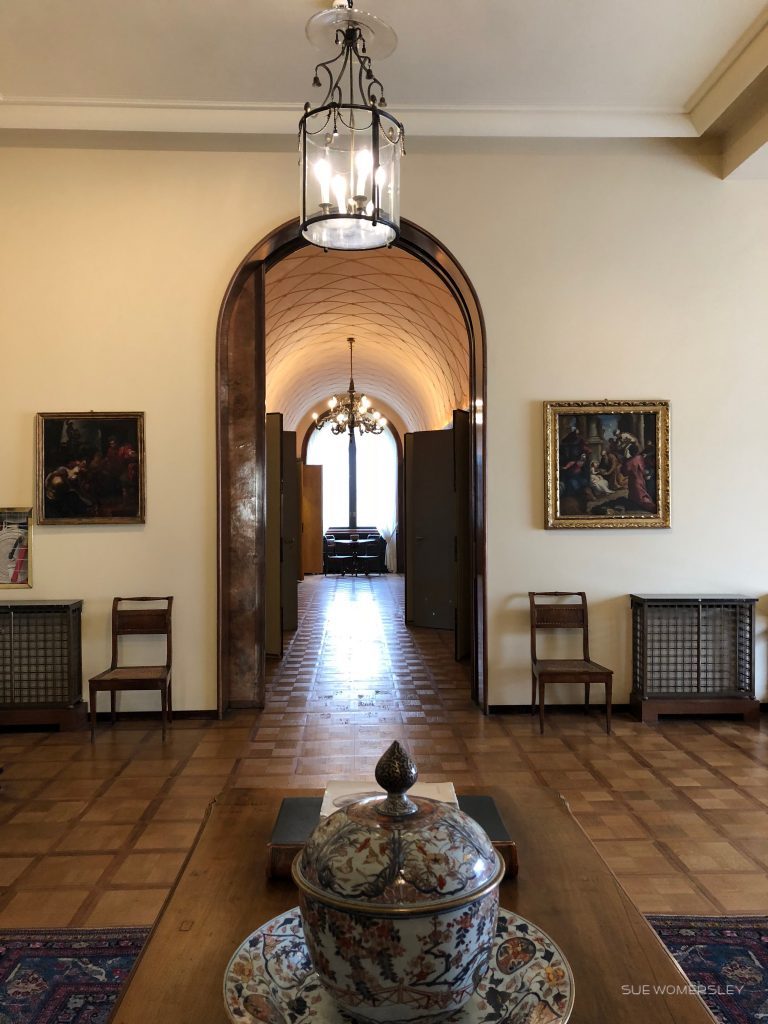
Upper floor landing – view to the bedroom wing

This stretch of hallway is is located between their suite and the sister’s and lined with custom closets for additional clothing, hats and accessories. Barrell ceiling, more diamond shaped detail on ceiling and parquet flooring.

Angelo and Gigina’s bathroom – grand, elegant and state of the art – huge tub, separate shower, separate w/c, and two sinks – which is double the plumbing and considered a show of wealth at the time. Beautiful marble detail.

Angelo and Gigina’s bedroom – embroidered silk bedding and draperies.

Nedda’s bathroom -mirrors the other.

Nedda’s bedroom.

Nedda’s custom closet.

Custom Christian Dior for both Nedda and Gigina.
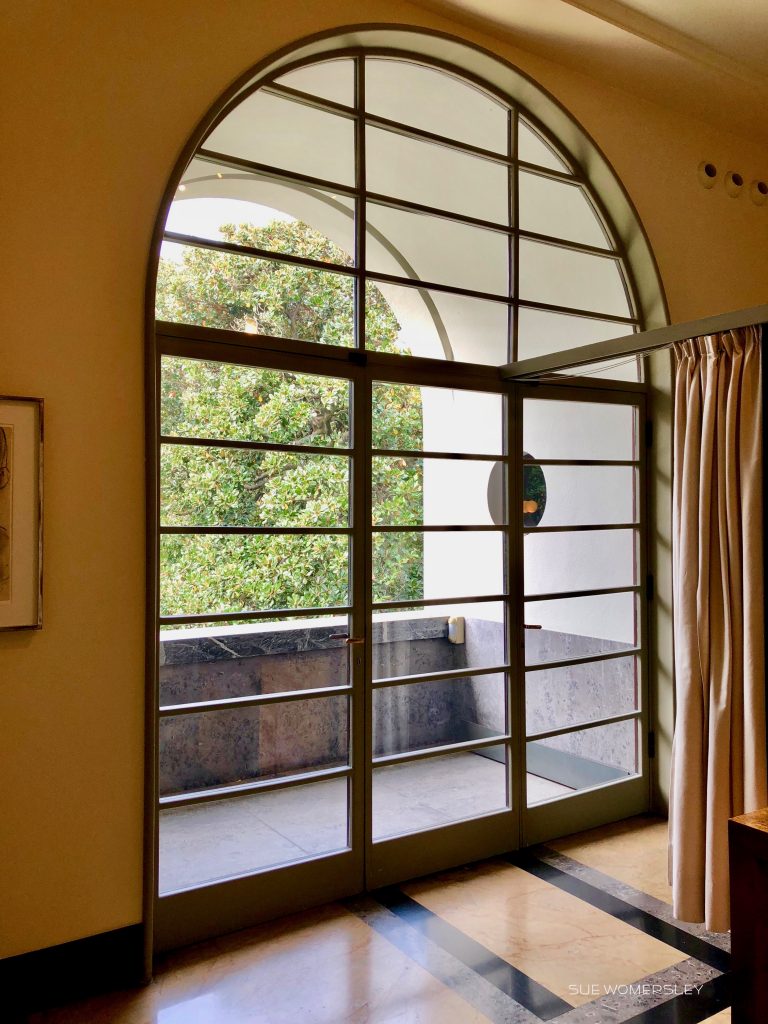
The window to the loggia above the front entrance. Located in the bathroom of the suite known as the Prince’s apartment, its frequent guest was a set designer for La Scala Theatre on his visits to Milan, Enrico d’Assia

Reflected in the mirror is a half wall of black Courso marble that divides the space between the bathroom and bedroom area and has an integrated curtain track for privacy.

Detail of a table top with inlaid brass.

The well designed wardrobe room. The wardrobe attendant was the only member of staff to live on the same floor as the homeowner, but as was customary there was a separate set of stairs. Her living quarters were lovely and had a full marble bathroom, and a view of the rear garden. All of the staff were long time and well looked after by the family.

Villa Necchi Campiglio was the first Villa in Milan to have its own private swimming pool (part of the original design by Portoluppi) – as well as a tennis court.

Exterior view to the jardin d’hiver. Behind me is the porter’s lodge and ingeniously, there is an underground tunnel for staff to go back and forth and not have to carry items outside in harsh weather.

Portoluppi designed marble structure for a wisteria walk the full length of the garden.
 Perfect cappuccino on the patio from the cafe, beside the pool. The tennis court is behind this wall.
Perfect cappuccino on the patio from the cafe, beside the pool. The tennis court is behind this wall.
 Sun dial on the side of the Villa, facing the tennis court – a signature of Portoluppi.
Sun dial on the side of the Villa, facing the tennis court – a signature of Portoluppi.
The Villa and its contents was donated to the Fondo Ambiente Italiano (FAI) the Italian National Trust, in 2001.
Villa Necchi Campiglio
Via Mozart 14, Milano NecchiCampiglio
open Wednesday – Sunday 10 – 6
My name is Sue Womersley and I am and Interior Designer in White Rock/ South Surrey, BC sharing my love of architecture, design, photography and travel with you. decorata.ca
other posts of Milan you may enjoy…
Villa Poldi Pezzoli – a 17th century villa and it vast collections of price objets from generations of two prominent families – considered one of the finest in Europe
Villa Bagatti Valsecchi – Italian Renaissance collection of brother Baron Fausto and Guiseppe from the late 19th century.

Leave a comment